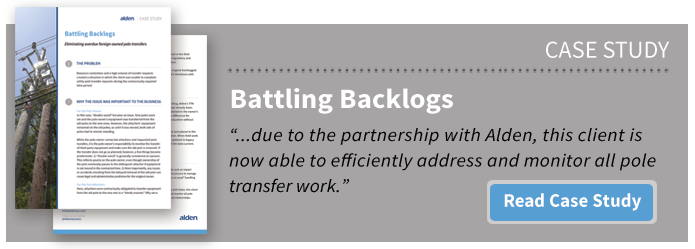Bad Poles: Do You Own Them & What is Your Liability?
 If the term "bad poles" sounds ominous, that is because it is—at least in terms of your organization’s appetite for risk. No one wants these unwanted and generally unneeded assets on their books, but your organization may have even assumed ownership of a few. What are they? Why do companies assume ownership of them? How extensive is the liability assumed with them? We have answers.
If the term "bad poles" sounds ominous, that is because it is—at least in terms of your organization’s appetite for risk. No one wants these unwanted and generally unneeded assets on their books, but your organization may have even assumed ownership of a few. What are they? Why do companies assume ownership of them? How extensive is the liability assumed with them? We have answers.
The "What" of Bad Poles
In the joint use world, a "bad" pole is any decommissioned utility pole that has been replaced with a new asset but is still standing next to its replacement. This often occurs because of a failure to transfer equipment from old to new utility pole. The double wood situation this creates is bad enough, but "bad" poles themselves are often structurally deficient, have been damaged by weather and/or nature, or have aged beyond their usefulness; hence their need to be replaced.
The "Why" of Bad Poles
When a new pole is deemed necessary for whatever reason, the owning company will erect the pole and move their equipment to the new structure, while at the same time requesting an equipment transfer from other attaching companies. These requests have a contractually dictated time limit (45 days is typical) for transfer work to be completed so the old pole can be removed. If that time elapses and equipment still has not been transferred, the pole owner can then transfer ownership of the old pole to the delinquent attacher.
Failing to transfer equipment can be a sign of other issues, though, from work overload to inadequate record keeping and communication that creates backlogs. As a result, often when ownership is transferred, the attaching company is already a few steps behind and may not know they now own the poles. Field assessment can remedy the problem—a one-by-one look at a company’s assets in the field can offer a good tally. Additionally, using an easily updatable, shared online solution that puts all information about field assets such as utility poles, work requests such as equipment transfers and joint use contracts at your fingertips can help your company keep backlogs at bay in the future.
The "How" of Bad Pole Liability
In most cases, if an equipment owner does not transfer their items in the contracted time frame, they will assume ownership of the pole. Perhaps more importantly, they will also assume all liability related to any damages created by a failure in the pole structure. These damages could potentially include property or personal injury claims and can be costly.
State law may limit the amount of liability; however, the joint use agreement between pole owner and pole attacher should reflect any rules, regulations and limitations that apply. Further, a pole owner could be party to a lawsuit stemming from pole-related damages, but once new ownership is assumed, the original owner would have grounds for indemnification based on the joint use agreement.
The point—and the warning: watch the clock and your assets. When the time for equipment transfer is up, if you are not careful, you could see your equipment inventory rise without purchasing a single pole.
For ways to avoid this "bad" pole situation, check back next week for some tips on how to keep things running smoothly.
How well (or not) does your company keep up with attachment and transfer requests? We'd love to hear any stories in the comments below.
